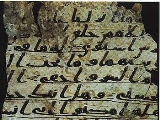Mahmud
The period of Moghul rule in India is considered as the Golden Period of Calligraphy. In all the literature available on the Net on calligraphy, I have not found any mention about some of the rarest and priceless pieces of Quranic calligraphy practiced during the reign of Emperor Aurangzeb, son of Emperor Shah Jahan, builder of the Taj Mahal, India. There was a whole section of highly skilled and well known calligraphists working in the Royal Palace of Emperor Aurangzeb and the Emperor himself an accomplished calligraphist earned his living through the writing of the Quran. He never signed or never revealed his contribution in the writing of the Holy Quran because it could lead to speculation and high prices. The Emperor of the largest empire (equalled perhaps by the Ming dynasty) never drew any income from the Royal Exchequer. Aurangzeb in his Will at Para two says: ’'Four Rupees and two annas (Indian currency), out of the price of the caps sewn by me, are with Aia Bega, the mahaldar. Take the amount and spend it on the shroud of this helpless creature. Three hundred and five Rupees, from the wages of copying the Quran, are in my purse for personal expense. Distribute them to the ‘faqirs’ (poor beggars) on the day of my death’’.


